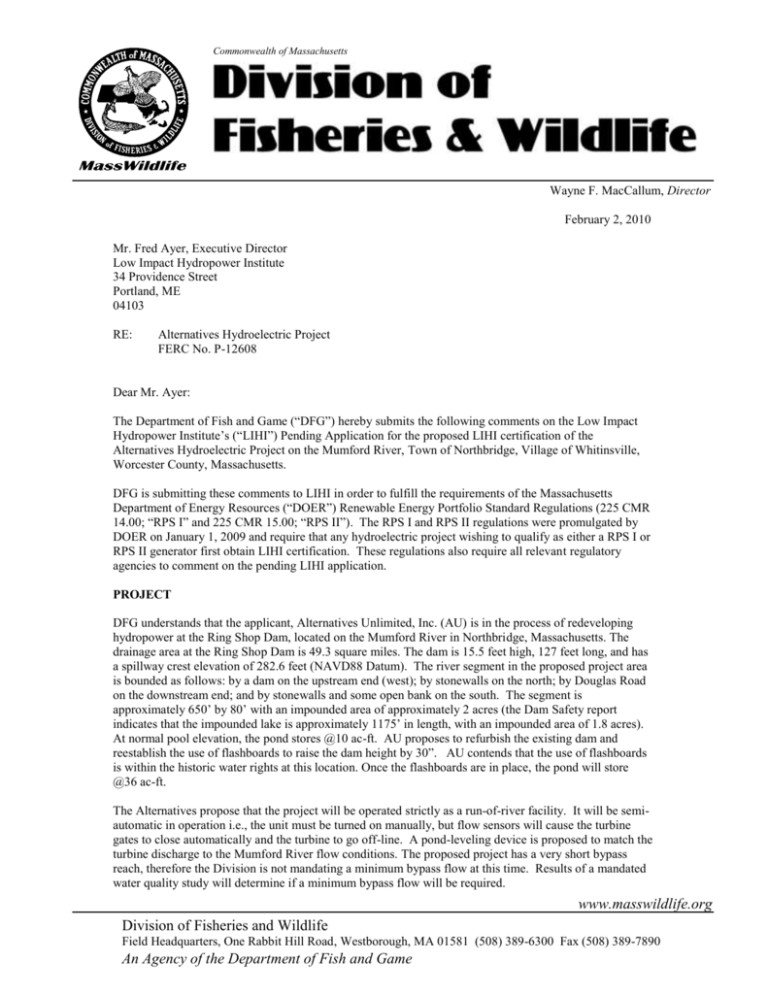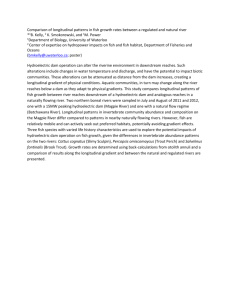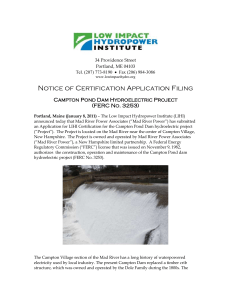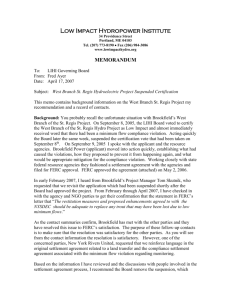AlternativesLIHIcomments - Low Impact Hydropower Institute
advertisement

Commonwealth of Massachusetts Wayne F. MacCallum, Director February 2, 2010 Mr. Fred Ayer, Executive Director Low Impact Hydropower Institute 34 Providence Street Portland, ME 04103 RE: Alternatives Hydroelectric Project FERC No. P-12608 Dear Mr. Ayer: The Department of Fish and Game (“DFG”) hereby submits the following comments on the Low Impact Hydropower Institute’s (“LIHI”) Pending Application for the proposed LIHI certification of the Alternatives Hydroelectric Project on the Mumford River, Town of Northbridge, Village of Whitinsville, Worcester County, Massachusetts. DFG is submitting these comments to LIHI in order to fulfill the requirements of the Massachusetts Department of Energy Resources (“DOER”) Renewable Energy Portfolio Standard Regulations (225 CMR 14.00; “RPS I” and 225 CMR 15.00; “RPS II”). The RPS I and RPS II regulations were promulgated by DOER on January 1, 2009 and require that any hydroelectric project wishing to qualify as either a RPS I or RPS II generator first obtain LIHI certification. These regulations also require all relevant regulatory agencies to comment on the pending LIHI application. PROJECT DFG understands that the applicant, Alternatives Unlimited, Inc. (AU) is in the process of redeveloping hydropower at the Ring Shop Dam, located on the Mumford River in Northbridge, Massachusetts. The drainage area at the Ring Shop Dam is 49.3 square miles. The dam is 15.5 feet high, 127 feet long, and has a spillway crest elevation of 282.6 feet (NAVD88 Datum). The river segment in the proposed project area is bounded as follows: by a dam on the upstream end (west); by stonewalls on the north; by Douglas Road on the downstream end; and by stonewalls and some open bank on the south. The segment is approximately 650’ by 80’ with an impounded area of approximately 2 acres (the Dam Safety report indicates that the impounded lake is approximately 1175’ in length, with an impounded area of 1.8 acres). At normal pool elevation, the pond stores @10 ac-ft. AU proposes to refurbish the existing dam and reestablish the use of flashboards to raise the dam height by 30”. AU contends that the use of flashboards is within the historic water rights at this location. Once the flashboards are in place, the pond will store @36 ac-ft. The Alternatives propose that the project will be operated strictly as a run-of-river facility. It will be semiautomatic in operation i.e., the unit must be turned on manually, but flow sensors will cause the turbine gates to close automatically and the turbine to go off-line. A pond-leveling device is proposed to match the turbine discharge to the Mumford River flow conditions. The proposed project has a very short bypass reach, therefore the Division is not mandating a minimum bypass flow at this time. Results of a mandated water quality study will determine if a minimum bypass flow will be required. www.masswildlife.org Division of Fisheries and Wildlife Field Headquarters, One Rabbit Hill Road, Westborough, MA 01581 (508) 389-6300 Fax (508) 389-7890 An Agency of the Department of Fish and Game AU was granted a FERC Exemption from License in December 2006 (FERC No. 12608). The Alternatives then determined that the proposed turbines (three 15kW cross flow units) were no longer available and amended their FERC exemption to install one 47 kW adjustable semi-Kaplan unit. Construction of the project is ongoing. DFG had no objection to this amendment as the new turbine will produce 5% more power (47 kW vs. 45kW) while using 20% less water (70 cfs vs. 90 cfs) and semi-Kaplan units are much more fish friendly than the originally proposed cross flow units. FISH AND WILDLIFE RESOURCES The Mumford River supports fish and aquatic resources, including a number of resident fish species, and freshwater mussels. While there are currently no populations of diadromous fish in the project area, fishery resource agencies are actively involved in diadromous fish restoration efforts within the watershed. While passage measures for diadromous fish will not be needed in the near term at the Project, it is possible that fishways will be required in the future. IMPACTS AND MITIGATION Run-of-river Operation The applicant proposes to operate the project in a true run-of-river mode, with inflow equal to outflow on an instantaneous basis. Maintaining natural flow through the project will protect the existing habitat which benefits fish and wildlife species. Downstream habitats will also benefit from run-of-river operation. The resulting stable flow regime will support the riverine assemblage in the free-flowing sections of river below the project. Bypass Flows Operation of the proposed project will result in a very short bypass reach (the section of river between the dam and the project tailrace). Presently, all inflow passes over the dam into this area. During the first field season following commencement of project operation, AU is required to conduct a flow study to determine if a bypass discharge will be required to maintain water quality and habitat in the bypass reach. Migratory fish While there are currently no populations of diadromous fish in the project area, fishery resource agencies are actively involved in diadromous fish restoration efforts within the watershed. Fishways are being constructed at the first three dams on the Blackstone River (in RI) and the fourth is scheduled to be removed. While passage measures for diadromous fish will not be needed in the near term at the Project, it is possible that fishways will be required in the future. COMMENTS If operated in accordance with the terms and conditions of the FERC exemption, the Alternatives Project has the potential to be a “Low Impact” Hydro project. However, technical issues have delayed the start of project operations. Consequently, the mandated bypass reach minimum flow study has not been preformed and no final minimum flow has been determined as required by the FERC exemption. Given the project owner’s cooperation to date, it is reasonable to expect that the above terms and conditions of the FERC exemption will be met. Until then, I am not in a position to certify a project as low impact before I have seen it in operation. If LIHI chooses to certify this project I would ask that any such certification be conditioned to require the project owner to comply with the remaining FERC exemption requirements within one year and to demonstrate at that time the facility is, in fact, operating as a “low Impact” facility. Thank you for this opportunity to comment. Sincerely, Caleb Slater, Ph.D. Anadromous Fish Project Leader









